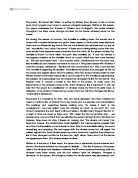Mending Wall by Robert Frost. Given the use of enjambment and blank verse in Mending Wall, I shall adopt a linear analysis of the poem in order to trace the evolving mindset of the speaker as the poem progresses.
IOC: Robert Frost
Mending Wall
Background to Poem
- Mending Wall is part of Robert Frost’s second anthology of poems entitled North of Boston published in 1914
- Having been a farmer, Frost is heavily influenced by nature, resulting in the natural settings and imagery used in many of his poems like the Wood Pile, After Apple Picking and Mending Wall
- On the surface, Mending Wall appears to be a poem where the speaker contemplates why he and his neighbour have to rebuild the wall demarcating their respective farmlands each spring.
- However, on a deeper level, the poem is less about the physical separation of the wall and more about the divergences in the modes of thought of two individuals and how the speaker tries to reconcile the mental differences that exist between him and his neighbour
Structure of Commentary
Given the use of enjambment and blank verse in Mending Wall, I shall adopt a linear analysis of the poem in order to trace the evolving mindset of the speaker as the poem progresses. However, I shall be focusing on three main points in this analysis:
- The portrayal of the speaker and his neighbour in the poem (1)
- The creation and use of irony (2)
- The changing meaning of the wall (3)
General Observations
- The poem can be seen to be divided into two portions, each ending with the neighbour’s unchanging apothegm: “Good fences make good neighbours”.
- Each portion contains its own unique significance to the subject matter of the poem. From lines 1 to 26, the speaker presents his argument against the absurdity of building the wall, to which his neighbour rebuts his stoic addage. From lines 28 to 42, the speaker develops a contentiousness against his neighbour, elucidating the personal differences that exist between them, ironically revealing the need for both characters to reconcile and mend fences, or in this case, the wall.
- As the poem progresses, there is increasing tension between the speaker and his neighbour as the speaker becomes increasingly aware of the differences in mindset between them. It is the speaker’s very own contention against the unpragmatic existence of the wall that places him in opposition to his conservative neighbour, ironically confining the speaker himself inside of his own beliefs, rendering him just as inflexible and unchanging as his “old stone savage” neighbour.
- By the end of the poem, the wall has become a symbol for the barrier between human contact and understanding. It is erected by all that is primitive, fearful, irrational and hostile (i.e. The neighbour) and is opposed by a higher, more progressive “something” (i.e. The speaker, and arguably Frost himself) who have become allegorical figures representing opposing views of freedom and confinement, reason and rigidity, tolerance and violence, civilisation and savagery.
Lines 0-4
- The title of the poem is significant as it creates an arresting image in the mind of the reader of two men mending the wall. Immediately this contextualises the literal subject matter of the poem, aiding understanding on the reader’s part as the poem develops
- In the first four lines of the poem, Frost reveals the speaker to be of a causal, light-hearted sort. Although there is a sense of whimsy and mystery about that “something that doesn’t love a wall”, the speaker introduces no complex subjects for the reader to consider. However, through his language and the rhythm of the lines, readers sense the underlying conflict in this poem
- From these few lines, readers also gain an idea of the speaker’s character. His discursive indirection, portrayed through the combination of the indefinite pronoun “Something” and the loose expletive construction “there is”, the speaker evokes a sense of ruminative vagueness and ambiguity even before the curious subject of walls is introduced.
- The use of informal, convoluted language provides a linguistic texture for the dramatic conflict, between the mindsets of the speaker and his neighbour, that develops later in the poem. The employment of anastrophe (inversion of grammatical syntax) serves to introduce the speaker as an unorthodox character with an unorthodox mindset (1)
- The speaker’s lively imagination is revealed (1) through his diction in describing the destruction of the wall. “Something… That sends the frozen-ground-swell under it… And spills the upper boulder in the sun,… And make gaps even two can pass abreast” The speaker anthropomorphizes this mysterious, seemingly intelligent force that wrecks the wall from year to year. The three active verbs used in lines 2 to 4 (sends...spills...make), create a sense of dynamism in the destruction of the wall, calling into question the need for the wall at all if nature herself opposes its existence.
- Frost’s diction in line 2, “...frozen-ground-swell…”, seems to imply that winter’s frost is what undermines the stability of the wall. The concealed pun indicates that Frost himself is against the existence of walls.








